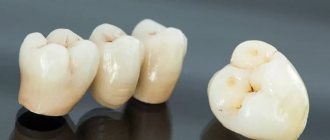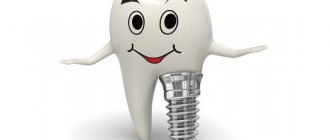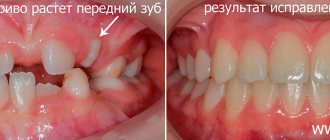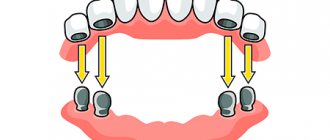Today, the possibilities of orthodontics make it possible to correct the bite not only of children, but also of adults. Among the orthodontist's patients, many people are 25-45 years old. By this age, many have undergone dental prosthetics at least once. Therefore, a common question that is asked to the orthodontist is: do they put braces on crowns? We'll tell you in the article.
In this article
- In what cases can braces be placed on prosthetic teeth?
- How does orthodontic design affect dentures?
- Is it possible to get braces if there is a crown on an implant?
- Specifics of orthodontic treatment in the presence of dentures
- How are braces with crowns installed on teeth?
- Conclusion
In what cases can braces be placed on prosthetic teeth?
Braces are dental structures for correcting bites and misaligned teeth. Small clasps are glued to the surface of each tooth and connected into a single system with a metal arch. It puts pressure on the teeth and helps straighten them.
Crowns are a type of permanent dental prosthesis that covers the visible part of a damaged tooth and takes over its functions. Artificial crowns are usually used to cover teeth that are more than half destroyed. Before answering the question whether it is possible to install braces if there is a crown, the orthodontist will evaluate the condition of the tooth under the prosthesis. If diagnostics show that, despite severe or complete destruction of the natural dental crown, the tooth root remains intact, then braces can be installed.
Depending on the dental task and the position of the tooth under the crown, the dentist makes one of two decisions:
- attach the bracket directly to the artificial crown;
- install a brace system, bypassing this tooth.
The first option is suitable for those patients who need to move a tooth under the crown to correct their bite or need it to perform a supporting function. The second option, when the bracket is not attached to the crown, is suitable for the correction of minor orthodontic disorders. This way, the tooth under the crown can be “switched off” from the general system without reducing the effectiveness of the treatment. The doctor decides which option will be optimal for a particular patient.
Preparing to install braces
Before gluing the leveling system, all existing dental diseases are treated. It is necessary to treat all carious cavities, pulpitis, and replace damaged dentures.
If an infection is diagnosed, anti-inflammatory therapy is carried out. It is forbidden to work with an incorrect bite until the pathology enters the “dormant” phase.
All teeth must be cleaned of plaque and tartar. For this purpose, the dental hygienist uses an ultrasonic scaler. It “knocks off” particles from the enamel and makes the tooth surface as smooth and clean as possible.
How does orthodontic design affect dentures?
Although installing braces on crowns is acceptable and, if necessary, the dentist carries out such a procedure, there are a number of negative aspects that the patient should know in advance:
- Loose fastening.
Braces are attached to the teeth using special dental glue. They adhere well to the surface of tooth enamel and adhere to it quite reliably. It is more difficult to attach braces to the smooth artificial surface of crowns because the adhesion is much worse.
- Damaged surface.
Once removed, glued clasps spoil the appearance of the artificial denture. This is due to the fact that for better adhesion to the bracket, the crowns are treated in a special way, making the surface less smooth and more rough. When the clasps are removed at the end of orthodontic treatment, it is very difficult to restore the absolute smoothness of the crown, even with the help of polishing.
- The crown does not fit the corrected bite.
The essence of orthodontic treatment most often lies in the correction of the bite. Braces move teeth to a different position. This can cause the crown to no longer fit the tooth. It can create discomfort when the teeth close together - it sticks out strongly, differs in height. In some cases, you can simply grind down the denture to adjust it to the new position of the tooth. But sometimes, with a strong correction, replacement of the denture is required. Due to such negative aspects, not everyone is ready to install braces on permanent crowns.
The optimal solution is when the patient needs prosthetics and at the same time bite correction. In this case, the orthopedic dentist can install a temporary denture (plastic or composite). Structures made from such materials are much cheaper than ceramic or metal ones, so if necessary, they can be removed without large financial losses. After prosthetics with a temporary structure, the orthodontist will install a brace system, and after orthodontic treatment is completed, it will be possible to replace the temporary denture with a permanent one. With this scheme, all the negative aspects of the impact of braces on crowns are excluded.
Stages of bite deformation in children and adults
Doctors distinguish several stages of bite deformation.
The first is considered the easiest. It is diagnosed when the patient has a curvature of one or more teeth - they may have an irregular shape or length, an abnormal inclination and location, or may be rotated around their own axis.
The second or middle stage involves malocclusion throughout the entire row on one jaw or both.
To the third, most severe stage, experts include pathologies associated with the abnormal structure and size of the maxillofacial apparatus relative to the skull, violation of the position of the upper and lower jaws relative to each other, and the degree of closure of the teeth.
Important! Any, even the most minor, deformation of the bite, at a minimum, leads to a violation of the aesthetics of the smile and facial proportions, and at a maximum – to serious health problems. For example, to dental diseases and gastrointestinal pathologies, to respiratory failure, hypertonicity of the masticatory muscles and overload of the maxillofacial joint, to headaches, to early loss of teeth.
Is it possible to get braces if there is a crown on an implant?
The root of a damaged tooth is not always preserved. To restore a dental unit, a modern and technological implantation method is often used. Its essence is that a rigid metal implant is implanted in place of a living root. The top is covered with an artificial crown. If the patient has such a structure in his mouth, then the correction of malocclusion will be in question. And only an orthodontist can make a decision about it after a thorough diagnosis.
The fact is that the displacement of teeth during bite correction occurs due to a certain mobility of living roots, which can shift under the pressure of the orthodontic structure. A stationary artificial pin—an implant—can simply fall out under such pressure. Therefore, in most cases, it is not possible to install braces on crowns under which the implant is hidden. The denture itself cannot be moved to prevent its rejection, and without its movement in the jaw, other teeth will not be able to take the correct position.
In some cases, the orthodontist may decide to install braces after all. But this requires that there is enough space in the jaw to move the teeth without affecting the implants or that the patient agrees to incomplete orthodontic correction.
Not a contraindication
- Childhood.
The whole question is which method of treatment to choose. For younger children, removable aligners are often chosen, and teenagers can wear the same aligners as adults. But you can start correcting your bite immediately after diagnosing the existing problem at any age.
- Older age.
There is no upper age limit. If your teeth are preserved and there is a need to correct their position, you can be treated by an orthodontist at any age.
- General diseases (with very rare exceptions).
Metabolic disorders, asthma, allergies and other systemic diseases almost never interfere with wearing orthodontic structures, since the materials are hypoallergenic, and no surgical intervention (as when installing implants) occurs. If the patient's general condition is satisfactory and he can visit the clinic, then most likely there are no obstacles.
Correcting your bite will not only give you a beautiful smile, but will also prevent many problems with your teeth and the health of your body in general. If you are unsure whether you can undergo orthodontic treatment, please contact your orthodontist and ask all your questions.
More articles on the topic:
- Can veneers correct crooked teeth?
- Reflections ceramic braces: advantages and features
Specifics of orthodontic treatment in the presence of dentures
Installing a braces system on an artificial surface is more difficult than on a real tooth. The fixation of an orthodontic structure on dentures has its own characteristics:
- Locks do not adhere well to artificial material, so before fixing, the dentist carries out additional surface treatment.
- This treatment may result in loss of smoothness and uniform color.
- If there is an implant, braces are most often not installed.
- After correction of the bite, the denture may no longer fit in shape.
- Under the pressure of the metal arc of the bracket system, the crown may fall off.
Thus, permanent artificial crowns, although not an absolute contraindication to orthodontic treatment, do complicate it. The patient will either have to change them after bite correction, or the doctor will not be able to move the teeth in the desired direction. The best option is to install braces on temporary crowns and then replace them with permanent ones.
Risks and complications you may encounter
If the orthotic system is attached to a prosthesis, there are certain risks. This means:
- An artificial element can suffer significant mechanical damage. Then you will have to replace it.
- Only the crown can unfold, but the root itself will remain in its original position.
- The pressure of the arc can cause unsightly chips on an expensive crown. You will have to put up with them.
- If the roots are dead, they may break. This is a very serious complication. Then you will need to remove braces, remove the prosthesis, and pull out the roots. After healing, it will be possible to carry out implantation or think about making a dental bridge.
- Slight change in facial symmetry. This is possible due to incorrect displacement of the roots located under the dentures.
- Unaesthetic appearance of the crown after removing braces. While natural enamel can regenerate, artificial materials cannot.
Considering the possible problems, the orthodontist must weigh the pros and cons and give his verdict to the patient. If the doctor says that orthodontic therapy is undesirable, then it is better to listen to his words. If, after an in-person examination and diagnostic procedures, the doctor concludes that the bite correction should take place without significant complications, then you can safely begin the alignment.
How are braces with crowns installed on teeth?
If you need prosthetics and want to correct uneven teeth or correct your bite, we recommend that you first make an appointment with dentists - an orthopedist and an orthodontist. The first one will suggest the best option for prosthetics, taking into account further orthodontic treatment. The second one will carry out diagnostics and evaluate which device to choose for bite correction. In some cases, it is advisable to first install a temporary crown and attach braces to it. In others, before prosthetics, you must first correct the bite in order to make room in the dentition for the future crown. The orthodontist and orthopedist together will draw up a plan for further treatment that will most quickly and effectively achieve the patient’s goals.
To achieve excellent treatment results, a number of conditions must be met:
- Carefully prepare your teeth for the installation of any dental structure. Cure caries, pulpitis, any inflammatory diseases of the oral cavity.
- Correct an abnormal bite and make room for high-quality prosthetics.
- It is necessary to ensure that there is sufficient bone tissue if the patient requires implantation.
- Choose physiologically shaped dentures that will look natural and perform all the functions of teeth.
- The patient must strictly observe the rules of hygiene throughout the treatment: brush his teeth with a special orthodontic brush, use an irrigator and other care devices.
Care instructions
Without proper care of braces and crowns, problems are unlikely to be avoided. Treatment is impossible without observing a number of important rules, which the attending dentist will definitely tell you about before sending your patient home. It is extremely important to brush your teeth daily, morning and evening, and after all meals and sugary drinks.
To maintain hygiene, both classic brushes with bristles of different hardness, as well as single-tuft options and brushes are perfect. You should also purchase a suitable rinse aid to treat the cavity after cleaning. It will not only remove food particles from hard-to-reach places, but also freshen your breath.
A device such as an irrigator has proven itself to be excellent. Additionally, you can purchase dental floss and therapeutic and prophylactic pastes. Braces need to be cleaned from all sides, paying attention to the areas under the clasps and archwire.
previous post
Why get braces?
next entry











